
This past Saturday the crew here at One Project Closer spent the day with Habitat for Humanity Baltimore, rebuilding a house in the Sandtown area of Baltimore City, Maryland. We shared the day with a dozen volunteers, working primarily on structural components of the house, including installing floor joists, installing a 3/4 inch plywood subfloor, adding fire stops to first and second floor walls, and adding additional plywood sheathing to the exterior of the house.
Habitat provides a great opportunity to learn construction techniques that apply to your own DIY projects, while at the same time helping others in need. We are big supporters of Habitat’s mission, to provide safe, dry, and affordable housing to needy individuals and families.
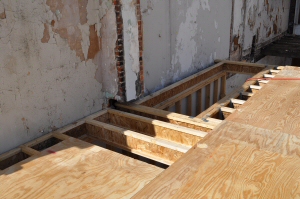
In this article, we’ll cover the installation of a 3/4″ plywood subfloor, including tips and pictures from our work with Habitat. As with all major construction projects, you should consider consulting a professional before attempting a job like this on your own. There are unique challenges in every plywood subfloor installation, including important building codes specific to your area that no single article could completely address.
3/4 Inch Plywood Subfloor Preparation: Joist Installation
The second floor of this house is built with 2 x 10 wood I-joists (joists that resemble steel I-beams and are 9.5 inches thick), 16″ on center and spanning 13.5 feet. These joists are stronger than comparable solid wood joists, provide a 66% larger nailing surface for the plywood subfloor (2.5 inches instead of 1.5 inches) and are more uniform than traditional lumber joists. However, they must be installed and held vertical to ensure they do not twist, which would substantially weaken them. Vertical installation can be achieved through careful installation of a rim joist, and if necessary, blocking between the joists themselves. Also, these joists are not as safe in a fire. Solid joists take longer to burn through, and will provide structural support longer. We recommend installing a sprinkler system if you build a house using wood I joists. (See our wood joist comparison.)
Later this week we will be showing wood I-joist installation, both with a rim joist, and without, in a situation where a rim joist cannot be installed due to the position of the wall next to an adjacent house.
It aids during installation if the joists are installed exactly 16 inches on center throughout the floor. At times it may be necessary to go shorter on this measurement, but when this happens, the plywood will need to be cut to accommodate the shorter length. Never go longer unless you have rechecked the spanning distance on the plywood and joists you are installing, as this could create a weak spot in the floor.
At 16″ on center, there will be 7 joists under each piece of plywood, and each piece will end in the middle of the next joist. The center of the first joist from the end will need to be installed 16 inches on center from the edge of the end of the house, as opposed to the middle of the joist, so that the plywood can start at the very edge of the house.
Installation is Easier in a Squared-up House
Prepping for a subfloor installation happens long before you are actually laying the plywood. If the house is out of square, it will make it exceedingly difficult to get the plywood straight on the joists. The wood i-joists are more forgiving than traditional joists because they have a wider nailing flange. Make sure that the foundation is square, that the first floor walls are square, and that the joists are square. Errors tend to compound as you work through these steps. Make sure your contractors are careful through each stage.
Steps to Install 3/4 Inch Plywood Subfloor
Step 1: Get the plywood to the right level of the house. Assuming a remodel, this is going to involve bringing the plywood to the location by hand, as opposed to assistance by a crane. Be careful! A 3/4 inch sheet of plywood weighs approximately 75 lbs. Don’t stack too much plywood on the same set of joists and overload them.
Step 2: Measure and dry-set the first piece. Your goal is to have the plywood end exactly half way across the joist, so that the new plywood can start on this spot. (There is a picture of this below.) Dry-setting is important. It is exceedingly important that the first whole line of plywood sheets be perfectly straight and square. Each subsequent piece of plywood will depend on the first piece being installed correctly. If you do this properly, you’ll have a beautiful plywood subfloor.
Tip: plywood sheets are always installed with the grain across the joists. Spanning ratings for plywood and OSB are based on this assumption. Stagger adjacent sheets so that they do not start on the same joist.
Step 3: Lift up the plywood and put construction adhesive across the joists. Liquid Nails for Subfloors is a common product for this job. This is made easier if you have a caulk gun designed for subfloor installation like the one shown below.
Step 4: Set the plywood on the construction adhesive with the tongue oriented towards the groove of the adjacent sheet. You likely won’t be able to push the plywood into place by hand. If you’ve positioned the plywood correctly, it should be sitting half-way over the joist, right next to the adjacent piece, as shown below.
Step 5: Tap the subfloor into place. This is best achieved using a sledge hammer and a tapping block. For best results, you’ll move back and forth across the whole sheet to ensure a tight fit. Don’t skip using the block. You’ll be hammer on the tongue edge of the board. The sledge hammer will easily mar the plywood subfloor making it difficult to fit the next sheet into place.
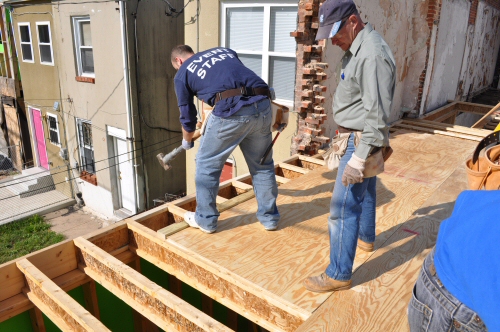
Step 6: Check that the sheet of plywood is square and tight against both sides. Then, using a hammer and nail to tap in two set nails, one at each corner. You should leave these nails about 3/4″ out of the plywood to make pulling them easy if everything isn’t right. The idea is to get the plywood fastened and take one last look before you fasten it completely.
It’s important to note that when installing the plywood sheets, do NOT nail within 10 inches of the side closest to the tongue UNTIL the adjacent sheet is hammered in. If you tighten the plywood down to the joists near the edge, it is much more difficult to install the sheet. You can see in the picture below that the set nail should be placed about 10 inches off the tongue edge of the board.
Remember, plywood only has a tongue and groove on the sides, not on the edges, since these will be nailed into the joist.
Step 7: If everything looks good, use a pneumatic framing nailer to fasten the boards to the joists. In this installation, we used Portable Cable’s Round Head framing nailer. We prefer 2 inch subfloor nails with reverse threads and coated in glue. Put a nail every 8-10 inches on the surface. Remember not to nail towards the last 10″ of the tongue side until the next sheet is installed. You can snap a chalk line across the joists to make nailing simpler.
You can see in this picture that the plywood sheets making up the subfloor in this house are tightly joined together. This will make installing surface flooring a much simpler task.
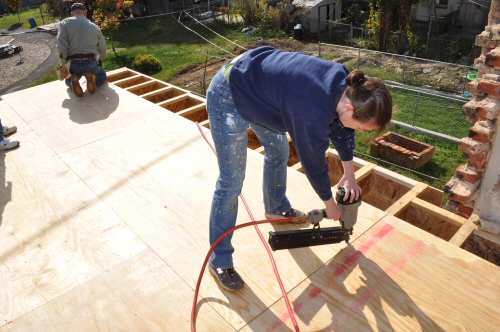
Step 8: Trim the edge of the floor by snapping a chalk line and cutting with a circular saw. We used a DeWALT 10″ circular saw for the job. Make sure no one is standing below so the pieces can fall freely to the ground.
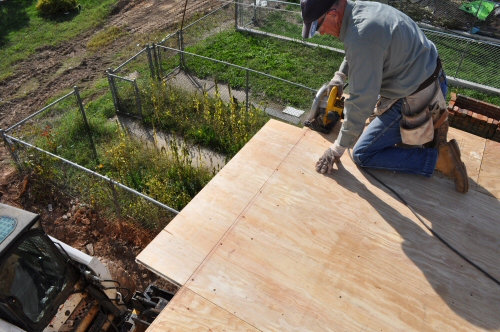
Step 9: At this point, the plywood subfloor is complete. Because this floor may be exposed to weather before the second floor and roof can be installed, we covered it with Zinsser Shellac. Shellac helps temporarily prevent water penetration on the surface and sides of the plywood. It is important to make sure the shellac covers the edges.
Shellac is not a long term solution to prevent the plywood subfloor from delaminating under the elements; however, it does provide some additional weather protection in the short term, and is worth the relatively small time and money investment for a project like this where it could be several weeks before the floor is under roof.
Another approach would be to completely cover the project with large tarps in between efforts.
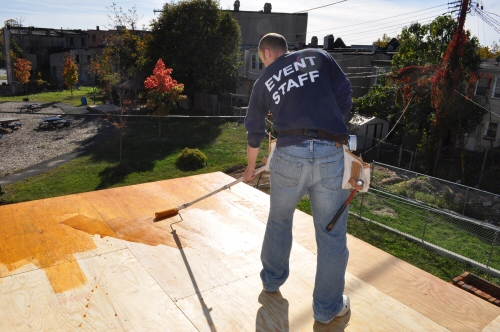
Tips for Plywood Subfloor Installation
- Consider both load bearing capacity and deflective properties when selecting subfloor materials. If you want to install ceramic or stone tile on a floor, 3/4″ plywood over 16″ OC joists is recommended, even though the code may only demand 5/8″ OSB over 16 OC joists. This also applies to joists depth. You may want to over-spec the joists in the home to limit deflection, installing 2×12 joists instead of 2x10s. There are also other trades between plywood and OSB. See that article for more details.
- Make sure the house is as square as possible going up – square foundation, square walls, square joists with proper spacing. Take our word for it: this is important and very hard to correct if done improperly.
- Install one sheet of plywood at a time. Make sure the plywood is square. Dry fit components first to make sure sheets land on the center of joists.
- Always install plywood or OSB long-ways across the joists. Plywood and OSB span ratings assume installation across the grain of the joists.

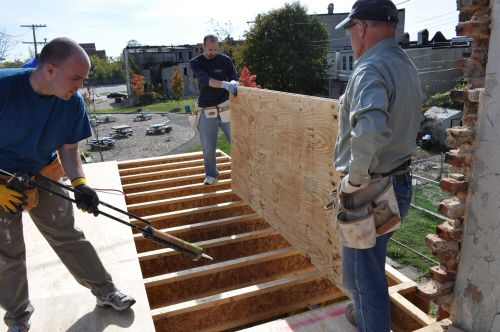






Fred,
Habitat is such a wonderful organization and helping them out is a bunch of fun.
Another alternative to using plywood and shellac is going with a product like AdvanTech for the sub-floor. AdvanTech is far superior when it comes to dealing with the elements and does not require any treatment. In fact, it can sit out in a full on rain storm and not be damaged. We’ve found that it’s the best choice for sub-floors.
I think the fire thing has been blown out of proportion with engineered lumber. Not sure I agree with the whole sprinkler recommendation as it’s a huge cost and not likely to change the outcome for a fire that’s so intense that it’s penetrated the drywall assemblies. I think it’s more important to focus on proper fire blocking and drywall details that will protect the framing in the event of fire.
It’s interesting to see in the photos that you guys were using I-Joists for the rim joist. Typically most framing today uses a cheaper rim-joist material like TimberStrand. It’s nice for several reasons, one it’s cheaper and two it’s a full width joist that doesn’t have a flimsy web to nail siding into.
Looks like you guys had a wonderful day for it!! Nice job.
A very noble project sir. thanks for sharing!!
Great job! You all do an amazing job of giving back to the community. Keep up the good work!
Hey Todd, Good thoughts on Advantech. I was thinking of the product while we were there and hopefully will get an opportunity to work with it as an alternative. I think you may be somewhat right on the fire potential. The real danger I see is in the floor collapsing prematurely with firefighting personnel going into the building… Covering with drywall probably gets you most of the way to a solution, especially with smoke detectors… but if it were in my house, particularly if it were in a first floor with an unfinished basement, I’d op for the sprinklers.
As for the rim joist, post is coming on that. This is a remodel of an end unit townhome. There is blocking between the i-beams on the side closest to the adjacent townhome that prevented the rim from being installed, but on the outside we used traditional 2×10 lumber framing nailed to the joists… I’ve seen some other rim joist solutions from GP and others that look like an OSB-type material, but haven’t encountered these yet.
That subfloor caulking gun saved a lot of crawling on the knees, as well as a bad back ache- definitely a handy tool for the job.
One other thing on the plywood sheathing. You need to leave an 1/8″ gap at the edges to allow for expansion. Some T&G products, like Advantech, already incorporate this in their product on the t&g side but you still have to space the ends and most people just stick an 8d nail between the sheets to give the correct spacing and then just take it out after nailing it in place. Also, the best application to prevent squeaks is to glue and screw the sheathing but most people opt for glue and nails.
Jonathon,
I am replacing the subfloor in a second floor bathroom due to some water damage. I was planning on using glue and screws since I do not have a nail gun. What kind of screws would you recommend for this job?
[…] how to install a plywood subfloor one project closer Tongue And Groove Plywood Subfloor Best Tongue And Groove Plywood Subfloor Gallery Size: 500 X 332 | Source: https://www.oneprojectcloser.com […]
How important is it to have the subfloor plywood lay across the joists compared to having the 4 x 8 sheet laying the long part of the sheet the same direction of the joists. I am replacing a floor that was done 25 years ago. This is how they laid the sheets. I plan on putting some type of block under the joists about half way. Is this a good idea or a bad one?
When putting a second layer of plywood is it still necessary to go perpendicular to the joist
I’m going to be rebuilding a 110 year old barn to live in an will be placing it on top of an ole existing house with a full basement, now I’m going to need to build primiter walls and use the full basement walls as a carry load do can I use treated 2x10s an osb plywood